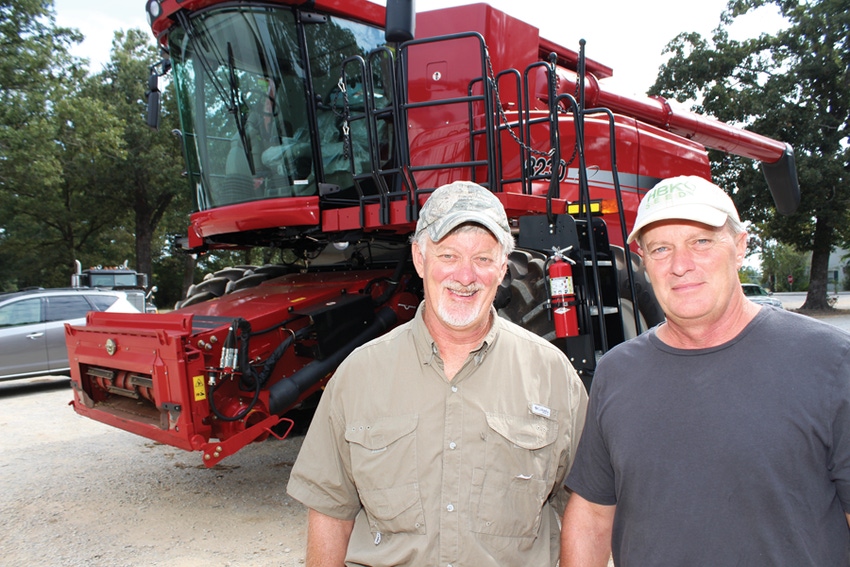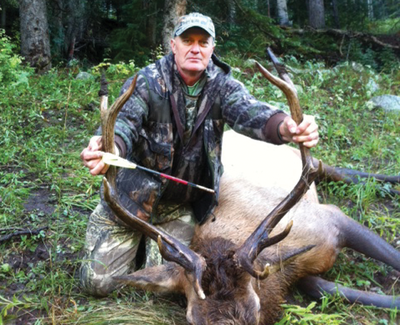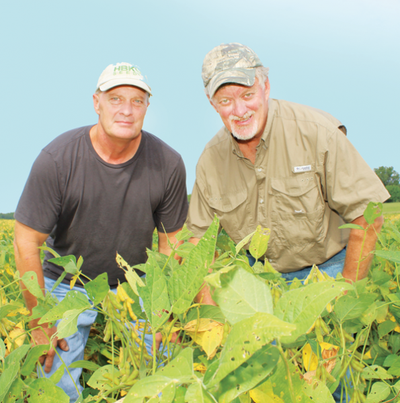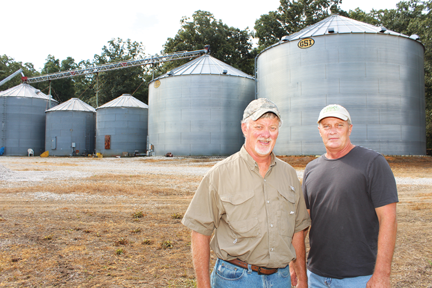
There is a touch of irony, Mike Pannell laughingly admits, that he’s chairman of the Mississippi Corn Promotion Board and president of the Mississippi Corn Growers Association, and yet he and his brother, Mark, have no corn this year on their 2,000 acre farms.
“We got sandbagged by the weather,” he says, a familiar story in much of the Mid-South this spring. “Dryland corn is not a very forgiving enterprise — we’ve basically got a one-shot window for getting things right. If weather knocks us out of that window, we have to go to soybeans.
“We’re all dryland, and we don’t like to plant corn beyond April 25 — the rainfall we need to get the crop up and mature becomes too risky after that date. In two years out of 10, we’ll be prevented from planting corn because of weather that pushes us too late in the season. The last time was 2009.
“This year, it rained every Thursday from the second week in March until the first week in May. When May rolled around, we had to give up on corn and go all soybeans. I told the board members of the corn organizations they’d probably want to fire me (he smiles), but so far they haven’t.”
Ag news delivered daily to your inbox: Subscribe to Delta Farm Press Daily.

THE ELK that Mark Pannell bagged on his Colorado bow-hunting trip.
On this late summer morning, with the expected start of soybean harvest still a while away, the brothers are trying to get things shipshape so they can take short vacations — Mike to go motorcycling with friends in Colorado (“When I turned 50, I felt I could finally afford a Harley-Davidson Classic,” he says), and Mark to go bow hunting for elk in Colorado (his bike is a Harley Road King).
They’ve been phoning around to try and locate a couple of needed oil filters for farm equipment, and Mark’s getting ready to drive up into Tennessee to get them (“A heckuva note,” he says, “that I’ve got to make a 90-mile one-way trip to pick up a couple of filters”).
Here in the northern part of Union County, cotton was long ago edged out by grains, and much of the land once in farms has gone into trees or the CRP. And in the Pannells’ case, land they once farmed surrounding their shop in the Glenfield community on the outskirts of New Albany, is now an industrial park and residential subdivisions.
“Some of it, we’d farmed for 20 years,” Mark says. “It was all rented land, and we had no opportunity to buy it before it went to development. Over the years, we’ve probably lost 200 acres to development. “
Now Mike says, “There’s little opportunity for any further expansion of our farming operation — there’s just not that much farmland left in this area.”
'Great group of landowners'
From their shop, their farms are spread 10 miles in every direction, with “probably 100-125 different fields,” he says. “It entails a lot of equipment movement, but many of the fields in a particular location are contiguous, so we don’t do a lot of traveling between fields. We own about 20 percent of the land, the rest is rented.”

EARLY SOYBEANS were rapidly maturing as hot, dry weather continued into September on Mark (left) and Mike Pannell’s northeast Mississippi farm.
“We have been blessed to work with a great group of landowners,” says Mark. “Some of them are retired farmers, and year-in and year-out we couldn’t ask for better folks to work with.”
It’s just as well that expansion potential is limited, Mike says, because they’re a two-man show — they do everything on the farms themselves; they don’t even have part-time help.
“What we’re farming now is about as much as we can handle from a grain volume standpoint,” he says. “I handle the mechanical work, planting, and grain hauling, and Mark looks after all the book work, spraying, and combining.
“At harvest time, Mark runs the combine and I run the four grain trucks, grain cart, and service truck. There’ll be just the two of us in the field and nine vehicles/pieces of machinery. When we start selling grain and moving it out after the first of the year, we’ll both drive the trucks.”
It keeps them hopping, Mike says, and it makes for some long days. “But we make it work. With all the industry in the area — including the new $2 billion Toyota automobile plant 25 miles down the road — the labor situation is tight, and it’s hard to find anyone interested in farm work.
“Like a lot of farmers, we’ve become more and more reliant on technology and on the advice and recommendations of crop consultants. I don’t walk out the door in the morning without my iPhone and iPad.
“I can access all our FSA field maps, variety/planting/yield data, ARCGIS mapping, Agrian Mobile, CaseIH and John Deere Parts Lookup, and various other ag-related apps. And with Internet access, I can pull up chemical information, university research, and markets.
“We have GPS on our tractors, combine, and sprayer, which has helped ease the workload, and enables us to run at night if we need to. We’ve looked at RTK, and while we could get more accuracy with it, I’m not sure, on our scattered, irregular-shaped fields, that we’d get that much additional benefit.”
No-till has also been a major benefit to their operation, Mike says. “We started moving to no-till 15 or 20 years ago and now are 100 percent. The fuel/labor/time/money savings has been tremendous. In fuel alone, we’ve gone from using two to three tanker loads a year to only one.”
Drying, storage facilitate harvest
On-farm storage has offered further benefits. “Having storage really helps at harvest time — we can cut corn and beans and unload on our on schedule, with no waiting in line at elevators. We have 120,000 bushels of storage, and we can store 100 percent of our crop.

ON-FARM STORAGE and continuous-flow drying allow Mike (left) and Mark Pannell to harvest corn early, at higher moisture, and to avoid time waiting in line at elevators.
“We have a continuous-flow dryer and we run all our corn through it. By being able to dry corn, we can harvest at higher moisture and we’re usually through harvesting before anyone else even starts. For our operation, I don’t see how we could grow corn without a dryer.
“We usually won’t hold corn past June, but we can store soybeans as long as two years. Right now, we don’t have any of this year’s crop forward contracted. Soybean prices spiked this week, and if there should be an early frost in the Midwest, we could see more price improvement. We’ll play it by ear.”
The Pannells sell their soybeans through Bungee Corp. at Memphis and corn to Sunshine Mills at Tupelo, Miss., and Pilgrim’s Pride at Tuscumbia, Ala.
“We didn’t sell any $18 beans in 2012,” Mike says, “but we had a lot booked at $13-$16, and we were pleased with that. We sold most of our corn in the $7.25-$8.25 range. We averaged 145 bushels of corn and 45 bushels of soybeans.”
While irrigation could offer yield advantages in dry years, he says, “We’re limited here by aquifer capacity, and wells would have to go so deep it would be prohibitively expensive.”
Soybeans varieties planted this year are Asgrow 4632 and 5332; Pioneer 94Y61, 95Y01, 95Y10, and 95Y40; and Dyna-Gro 39YR57. Corn varieties last year were Pioneer 33N58 and Dekalb 6469 and 6697. “All have performed well for us,” Mike says.
They burn down in early spring with Roundup, Sharpen, and 2,4-D. “We never use Roundup alone, and we include residuals in order to help avoid resistant weeds. There has been some resistant pigweed documented in the county, but so far we’ve had none and our program has provided good control. For corn, we’ll follow with a 1/2-gallon atrazine application.”
Their equipment lineup includes both green and red: a John Deere 4730 sprayer with a 100-foot boom, and a Deere 8430 field cultivator, “in case we need to do some spot tillage”; a CaseIH 1631 pivot planter (16 30-inch rows for corn and 31 15-inch rows for soybeans); and a CaseIH 8320 combine with a 35-foot draper head.
“We soil test and base our fertility programs on those recommendations,” Mike says. “For corn, we’ve been making a blanket application of 10-26-26, with a sidedress of 160 lbs. equivalent of liquid nitrogen.
“Insects are not usually a problem, and this year we’ve not needed insecticides or fungicides. We had to replant about 35 acres of beans this year because of deer damage. Thus far, we’ve not had any damage from wild hogs, though they are a problem for some farmers in adjacent counties.
“We’ve had a few sporadic incidences of aflatoxin, but since 1996 we’ve probably had less than 10 loads of corn turned down. We had three loads rejected in last year’s crop.
“But as long as it’s under 100 parts per billion, we can move it for poultry feed and cattle feed, so it’s not a complete loss. I think because we can dry our corn the potential for aflatoxin is reduced.”
A farming way of life
Mike, Mark, and their brother, Jeff, who is chief marketing officer for the Tennessee Farm Bureau Federation, grew up in a farming environment.
“Our grandfather, Boyce Pannell, and our father, Jerrell, had a plumbing/electrical business that was their main livelihood,” Mike says, “but both always farmed on the side — mostly cotton in the 1960s and ‘70s. They never had more than 200 to 300 acres.

“I WOULDN’T go out the door in the morning without my iPad and iPhone,” says Mike Pannell, who with his brother, Mark, makes use of these and other technologies to manage operations on their farms.
“We boys grew up helping out on the farm and in the business, so we had a good indoctrination into the farming life and things mechanical/electrical.”
Mike graduated from the University of Mississippi in 1981 with a degree in pre-med physics, and had hoped to get a job working with TVA’s nuclear division.
“But TVA was in the process of mothballing plants,” he says, “so that career potential wasn’t very promising. Mark, who had gone to Ole Miss too, had already come back to the farm, so I joined him and we started renting land and expanding the operation.
“We also had cattle for many years — a cow/calf operation, running as many as 150 cows — but we got out of that in 1996. We had pastures scattered over two counties and it was just too demanding. We could get better returns on our time from crops.
“We last grew cotton in 1990. We got out mainly because of low yields and the unsuitability of our land — cotton just didn’t do well on our wet bottomland. Too, it’s a more expensive crop and it requires more attention than corn and beans, although it’s about got to the point that soybeans require as much attention through the season as cotton.”
Mike says he’s proud of the work the Mississippi Corn Promotion Board has done since it was established in 2007 as part of the legislation that created the state’s 1-cent per bushel corn checkoff program. He was elected chairman for a two-year term.
“We have an outstanding group of farmers on the board and an active, supportive membership,” he says. “Our budget has grown from $250,000 the first year to $1.2 million this year. Ninety-five percent of that stays in the state, most of it for research and promotion. The other 5 percent is for the state’s membership in the National Corn Growers Association to support its lobbying/legislative efforts.
“The Corn Promotion Board board is prohibited from doing any kind of lobbying, so anything in Washington needs to go through the grower associations.
“Through the National Corn Growers Association, we’re also supporting AMCOE (Aflatoxin Mitigation Center of Excellence), which includes Mississippi, Alabama, Arkansas, Georgia, Louisiana, North Carolina, and Texas.
“Mississippi has contributed $100,000 toward the organization’s aflatoxin research programs, and about $85,000 of that has come back for projects at Mississippi State University.”
This is the first year of operation for the Corn Promotion Board’s website (mscorn.org), Mike says. “We’re really pleased to make this resource available to the state’s producers — it is growing into a valuable reference library for corn research and production information.
Mike has also been been president of the Mississippi Corn Growers Association for the past five years. He is a member of the board of the Mississippi Farm Bureau Federation’s Foundation and Relief Fund; the North Mississippi Extension Advisory Committee; and chairman of the Union County Soil and Water Conservation District, and the Union County Fair Association.
Mark is a director of the Union County Farm Bureau Federation and a member of the FSA County Committee.
About the Author(s)
You May Also Like




